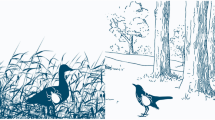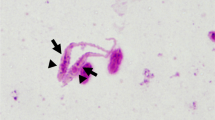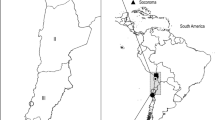Abstract
The Amblyomma maculatum Koch group of ixodid ticks consists of three species: A. maculatum, A. triste, and A. tigrinum. However, since Koch described this group in 1844, the systematics of its members has been the subject of ongoing debate. This is especially true of A. maculatum and A. triste; recent molecular analyses reveal insufficient genetic divergence to separate these as distinct species. Further confounding this issue is the discovery in 2014 of A. maculatum group ticks in southern Arizona (AZ), USA, that share morphological characteristics with both A. triste and A. maculatum. To biologically evaluate the identity of A. maculatum group ticks from southern Arizona, we analyzed the reproductive compatibility between specimens of A. maculatum group ticks collected from Georgia (GA), USA, and southern Arizona. Female ticks from both Arizona and Georgia were mated with males from both the Georgia and Arizona Amblyomma populations, creating two homologous and two heterologous F1 cohorts of ticks: GA ♀/GA ♂, AZ ♀/AZ ♂, GA ♀/AZ ♂, and AZ ♀/GA ♂. Each cohort was maintained separately into the F2 generation with F1 females mating only with F1 males from their same cohort. Survival and fecundity parameters were measured for all developmental stages. The observed survival parameters for heterologous cohorts were comparable to those of the homologous cohorts through the F1 generation. However, the F1 heterologous females produced F2 egg clutches that did not hatch, thus indicating that the Arizona and Georgia populations of A. maculatum group ticks tested here represent different biological species.

Similar content being viewed by others
References
Allerdice MEJ, Beati L, Yaglom H, Lash RR, Delgado-de la Mora J, Licona-Enriquez JD, Delgado-de la Mora D, Paddock CD (2017) Rickettsia parkeri (Rickettsiales: Rickettsiaceae) detected in ticks of the Amblyomma maculatum (Acari: Ixodidae) group collected from multiple locations in southern Arizona, USA. J Med Entomol 54:1743–1749
Balashov YS, Grigor'eva LA, Oliver JD (1998) Reproductive isolation and interspecific hybridization in ixodid ticks of the Ixodes ricinus —I. persulcatus group (Acarina, Ixodidae). Entomol Rev 78:500–508
Bretz F, Hothorn T, Westfall P (2011) Multiple comparisons using R. CRC Press, Boca Raton
Camicas JL, Hervy JP, Adam F, Morel PC (1998) Les tiques du monde: nomenclature, stades décrits, hôtes, répartition (Acarida, Ixodida). ORSTOM, Paris
Clarke FC, Pretorius E (2005) A comparison of geometric morphometric analyses and cross-breeding as methods to determine relatedness in three Amblyomma species (Acari: Ixodidae). Int J Acarol 31:393–405
Cohen EB, Auckland LD, Marra PP, Hamer SA (2015) Avian migrants facilitate invasions of Neotropical ticks and tick-borne pathogens into the United States. Appl Environ Microbiol 81:8366–8378
Conti-Díaz IA, Moraes-Filho J, Pacheco RC, Labruna MB (2009) Serological evidence of Rickettsia parkeri as the etiological agent of rickettsiosis in Uruguay. Rev Inst Med Trop São Paulo 51:337–339
Dantas-Torres F (2018) Species concepts: what about ticks? Trends Parasitol 34:1017–1026
Dantas-Torres F, Latrofa MS, Ramos RAN, Lia RP, Capelli G, Parisi A, Porretta D, Urbanelli S, Otranto D (2018) Biological compatibility between two temperate lineages of brown dog ticks, Rhipicephalus sanguineus (sensu lato). Parasit Vector 11:398
Drummond RO, Ernst SE, Trevino JL, Gladney WJ, Graham OH (1973) Boophilus annulatus and B. microplus: laboratory tests of insecticides. J Econ Entomol 66:130–133
Estrada-Peña AJ, Venzal M, Mangold AJ, Cafrune MM, Guglielmone AA (2005) The Amblyomma maculatum Koch, 1844 (Acari: Ixodidae: Amblyomminae) tick group: diagnostic characters, description of the larva of A. parvitarsum Neumann, 1901, 16S rDNA sequences, distribution and hosts. Syst Parasitol 60:99–112
Fagerberg AJ, Fulton RE, Black Iv WC (2001) Microsatellite loci are not abundant in all arthropod genomes: analyses in the hard tick, Ixodes scapularis and the yellow fever mosquito, Aedes aegypti. Insect Mol Biol 10:225–236
Ferrari FA, Goddard J, Paddock CD, Varela-Stokes AS (2012) Rickettsia parkeri and Candidatus Rickettsia andeanae in Gulf Coast ticks, Mississippi, USA. Emerg Infect Dis 18:1705–1707
Fornadel CM, Zhang X, Smith JD, Paddock CD, Arias JR, Norris DE (2011) High rates of Rickettsia parkeri infection in Gulf Coast ticks (Amblyomma maculatum) and identification of "Candidatus Rickettsia andeanae" from Fairfax County, Virginia. Vector Borne Zoonotic Dis 11:1535–1539
Gladney WJ, Dawkins CC (1973) Experimental interspecific mating of Amblyomma maculatum and A. americanum. Ann Entomol Soc Am 66:1093–1097
Goddard J (2002) A ten-year study of tick biting in Mississippi: implications for human disease transmission. J Agromed 8:25–32
Goddard J, Allerdice MEJ, Portugal JS, Moraru GM, Paddock CD, King J (2020) What is going on with the genus Dermacentor? Hybridizations, introgressions, oh my! J Med Entomol 57:653–656
Graham OH, Price MA, Trevino JL (1972) Cross-mating experiments with Boophilus annulatus and B. microplus (Acarina: Ixodidae). J Med Entomol 9:531–537
Guglielmone AA, Beati L, Barros-Battesti DM, Labruna MB, Nava S, Venzal JM, Mangold AJ, Szabo MP, Martins JR, Gonzalez-Acuna D, Estrada-Pena AJ (2006) Ticks (Ixodidae) on humans in South America. Exp Appl Acarol 40:83–100
Guzmán-Cornejo C, Pérez TM, Nava S, Guglielmone AA (2006) Confirmation of the presence of Amblyomma triste Koch, 1844 (Acari: Ixodidae) in Mexico. Syst Appl Acarol 11:47–50
Guzmán-Cornejo C, Robbins R, Guglielmone A, Montiel G, Pérez TM (2011) The Amblyomma (Acari: Ixodida: Ixodidae) of Mexico: identification keys, distribution and hosts. Zootaxa 2998:16–38
Haldane JBS (1922) Sex ratio and unisexual sterility in hybrid animals. J Genet 12:101–109
Hecht JA, Allerdice MEJ, Karpathy SE, Yaglom H, Casal M, Lash RR, Delgado-de la Mora J, Licona-Enriquez JD, Delgado-de la Mora D, Groschupf K, Moors A, Swann D, Paddock CD (2020) Distribution and occurrence of Amblyomma maculatum (Acari: Ixodidae) sensu lato and Rickettsia parkeri (Rickettsiales: Rickettsiaceae), Arizona and New Mexico, 2017–2019. J Med Entomol. https://doi.org/10.1093/jme/tjaa130
Herrick KL, Pena SA, Yaglom HD, Layton BJ, Moors A, Loftis AD, Condit ME, Singleton J, Kato CY, Denison AM, Ng D, Mertins JW, Paddock CD (2016) Rickettsia parkeri rickettsiosis, Arizona, USA. Emerg Infect Dis 22:780–785
Jiang J, Stromdahl EY, Richards AL (2012) Detection of Rickettsia parkeri and Candidatus Rickettsia andeanae in Amblyomma maculatum Gulf Coast ticks collected from humans in the United States. Vector Borne Zoonotic Dis 12:175–182
Jones EK (1972) Ticks of Venezuela (Acarina: Ixodoidea) with a key to the species of Amblyomma in the Western Hemisphere. Brigham Young Univ Sci Bull Biol Ser 17:4
Koch CL (1844) Systematische übersicht über die Ordnung der Zecken. Arch Naturgesch 10:217–239
Kohls GM (1956) Concerning the identity of Amblyomma maculatum, A. tigrinum, A. triste, and A. ovatum of Koch, 1844. P Entomol Soc Wash 58:143–147
Labruna MB, Naranjo V, Mangold AJ, Thompson C, Estrada-Pena A, Guglielmone AA, Jongejan F, de la Fuente J (2009) Allopatric speciation in ticks: genetic and reproductive divergence between geographic strains of Rhipicephalus (Boophilus) microplus. BMC Evol Biol 9:46
Labruna MB, Soares JF, Martins TF, Soares HS, Cabrera RR (2011) Cross-mating experiments with geographically different populations of Amblyomma cajennense (Acari: Ixodidae). Exp Appl Acarol 54:41–49
Lado P, Nava S, Mendoza-Uribe L, Caceres AG, Delgado-de la Mora J, Licona-Enriquez JD, Delgado-de la Mora D, Labruna MB, Durden LA, Allerdice MEJ, Paddock CD, Szabo MPJ, Venzal JM, Guglielmone AA, Beati L (2018) The Amblyomma maculatum Koch, 1844 (Acari: Ixodidae) group of ticks: phenotypic plasticity or incipient speciation? Parasit Vector 11:610
Lee JK, Moraru GM, Stokes JV, Wills RW, Mitchell E, Unz E, Moore-Henderson B, Harper AB, Varela-Stokes AS (2016) Rickettsia parkeri and "Candidatus Rickettsia andeanae" in questing Amblyomma maculatum (Acari: Ixodidae) from Mississippi. J Med Entomol 54(2):476–480
Levin ML, Schumacher LB (2016) Manual for maintenance of multi-host ixodid ticks in the laboratory. Exp Appl Acarol 70:343–367
Levin ML, Studer E, Killmaster LF, Zemtsova G, Mumcuoglu KY (2012) Crossbreeding between different geographical populations of the brown dog tick, Rhipicephalus sanguineus (Acari: Ixodidae). Exp Appl Acarol 58:51–68
Martins TF, Labruna MB, Mangold AJ, Cafrune MM, Guglielmone AA, Nava S (2014) Taxonomic key to nymphs of the genus Amblyomma (Acari: Ixodidae) in Argentina, with description and redescription of the nymphal stage of four Amblyomma species. Ticks Tick Borne Dis 5:753–770
Mayr E (1970) Populations, species, and evolution. The Belknap Press of Harvard University Press, Cambridge
Mays SE, Houston AE, Trout Fryxell RT (2016) Specifying pathogen associations of Amblyomma maculatum (Acari: Ixodidae) in western Tennessee. J Med Entomol 53(2):435–440
Melo AL, Alves AS, Nieri-Bastos FA, Martins TF, Witter R, Pacheco TA, Soares HS, Marcili A, Chitarra CS, Dutra V, Nakazato L, Pacheco RC, Labruna MB, Aguiar DM (2015) Rickettsia parkeri infecting free-living Amblyomma triste ticks in the Brazilian Pantanal. Ticks Tick Borne Dis 6:237–241
Mertins JW, Moorhouse AS, Alfred JT, Hutcheson HJ (2010) Amblyomma triste (Acari: Ixodidae): new North American collection records, including the first from the United States. J Med Entomol 47:536–542
Mukherjee N, Beati L, Sellers M, Burton L, Adamson S, Robbins RG, Moore F, Karim S (2014) Importation of exotic ticks and tick-borne spotted fever group rickettsiae into the United States by migrating songbirds. Ticks Tick Borne Dis 5:127–134
Nadolny EM, Wright CL, Sonenshine DE, Hynes WL, Gaff HD (2014) Ticks and spotted fever group rickettsiae of southeastern Virginia. Ticks Tick Borne Dis 5:53–57
Nava S, Elshenawy Y, Eremeeva ME, Sumner JW, Mastropaolo M, Paddock CD (2008) Rickettsia parkeri in Argentina. Emerg Infect Dis 14:1894–1897
Nava S, Mangold AJ, Mastropaolo M, Venzal JM, Fracassi N, Guglielmone AA (2011) Seasonal dynamics and hosts of Amblyomma triste (Acari: Ixodidae) in Argentina. Vet Parasitol 181:301–308
Nava S, Gerardi M, Szabo MP, Mastropaolo M, Martins TF, Labruna MB, Beati L, Estrada-Pena A, Guglielmone AA (2016) Different lines of evidence used to delimit species in ticks: a study of the South American populations of Amblyomma parvum (Acari: Ixodidae). Ticks Tick Borne Dis 7:1168–1179
Oliver JHJ (1989) Biology and systematics of ticks (Acari:Ixodida). Annu Rev Ecol Evol Syst 20:397–430
Oliver JHJ, Wilkinson PR, Kohls GM (1972) Observations on hybridization of three species of North American Dermacentor ticks. J Parasitol 58:380–384
Paddock CD, Goddard J (2015) The evolving medical and veterinary importance of the Gulf Coast tick (Acari: Ixodidae). J Med Entomol 52:230–252
Paddock CD, Finley RW, Wright CS, Robinson HN, Schrodt BJ, Lane CC, Ekenna O, Blass MA, Tamminga CL, Ohl CA, McLellan SL, Goddard J, Holman RC, Openshaw JJ, Sumner JW, Zaki SR, Eremeeva ME (2008) Rickettsia parkeri rickettsiosis and its clinical distinction from Rocky Mountain spotted fever. Clin Infect Dis 47:1188–1196
Paddock CD, Hecht JA, Green AN, Waldrup KA, Teel PD, Karpathy SE, Johnson TL (2020) Rickettsia parkeri (Rickettsiales: Rickettsiaceae) in the sky islands of West Texas. J Med Entomol. https://doi.org/10.1093/jme/tjaa059
Pagac BB, Miller MK, Mazzei MC, Nielsen DH, Jiang J, Richards AL (2014) Rickettsia parkeri and Rickettsia montanensis, Kentucky and Tennessee, USA. Emerg Infect Dis 20:1750–1752
Portillo A, García-García C, Sanz MM, Santibáñez S, Venzal JM, Oteo JA (2013) A confirmed case of Rickettsia parkeri infection in a traveler from Uruguay. Am J Trop Med 89:1203–1205
Portugal JS 3rd, Goddard J (2016) Evaluation of human attachment by larval Amblyomma maculatum (Acari: Ixodidae). J Med Entomol 53:451–453
Romer Y, Seijo AC, Crudo F, Nicholson WL, Varela-Stokes A, Lash RR, Paddock CD (2011) Rickettsia parkeri rickettsiosis, Argentina. Emerg Infect Dis 17:1169–1173
Silveira I, Pacheco RC, Szabo MP, Ramos HG, Labruna MB (2007) Rickettsia parkeri in Brazil. Emerg Infect Dis 13:1111–1113
Spickett AM, Malan JR (1978) Genetic incompatibility between Boophilus decoloratus (Koch, 1844) and Boophilus microplus (Canestrini, 1888) and hybrid sterility of Australian and South African Boophilus microplus (Acarina: Ixodidae). Onderstepoort J Vet 45:149–153
Teel PD, Ketchum HR, Mock DE, Wright RE, Strey OF (2010) The Gulf Coast tick: a review of the life history, ecology, distribution, and emergence as an arthropod of medical and veterinary importance. J Med Entomol 47:707–722
Trout Fryxell RT, Steelman CD, Szalanski AL, Billingsley PM, Williamson PC (2015) Molecular detection of Rickettsia species within ticks (Acari: Ixodidae) collected from Arkansas, United States. J Med Entomol 52:500–508
Varela-Stokes AS, Paddock CD, Engber B, Toliver M (2011) Rickettsia parkeri in Amblyomma maculatum ticks, North Carolina, USA, 2009–2010. Emerg Infect Dis 17:2350–2353
Venzal JM, Portillo A, Estrada-Pena A, Castro O, Cabrera PA, Oteo JA (2004) Rickettsia parkeri in Amblyomma triste from Uruguay. Emerg Infect Dis 10:1493–1495
Venzal JM, Estrada-Pena A, Castro O, de Souza CG, Felix ML, Nava S, Guglielmone AA (2008) Amblyomma triste Koch, 1844 (Acari: Ixodidae): hosts and seasonality of the vector of Rickettsia parkeri in Uruguay. Vet Parasitol 155:104–109
Wright CL, Nadolny RM, Jiang J, Richards AL, Sonenshine DE, Gaff HD, Hynes WL (2011) Rickettsia parkeri in Gulf Coast ticks, southeastern Virginia, USA. Emerg Infect Dis 17:896–898
Yaglom HD, Casal M, Carson S, O'Grady CL, Dominguez V, Singleton J Jr, Chung I, Lodge H, Paddock CD (2020) Expanding recognition of Rickettsia parkeri rickettsiosis in southern Arizona, 2016–2017. Vector Borne Zoonotic Dis 20:82–87
Zahler M, Gothe R (1997) Evidence for the reproductive isolation of Dermacentor marginatus and Dermacentor reticulatus (Acari: Ixodidae) ticks based on cross-breeding, morphology and molecular studies. Exp Appl Acarol 21:685–696
Acknowledgements
The authors would like to thank the Animal Resources Branch and veterinary staff at CDC for their care of the experimental animals. We would also like to acknowledge Luke Allerdice of Allerdice Photography for processing the images in Fig. 1 and Lorenza Beati for discussions and input on crossmating. The findings and conclusions of this study are those of the authors and do not necessarily represent the views of the Centers for Disease Control and Prevention.
Funding
Funding for this study was provided by the Centers for Disease Control and Prevention. No outside funding was received.
Author information
Authors and Affiliations
Corresponding author
Ethics declarations
Conflict of interest
The authors declare no conflicts of interest or competing interests.
Ethical approval
All animal studies were performed according to the protocol 2904LEVRABC approved by the Institutional Animal Care and Use Committee (IACUC) of the Centers for Disease Control and Prevention.
Additional information
Publisher's Note
Springer Nature remains neutral with regard to jurisdictional claims in published maps and institutional affiliations.
Rights and permissions
About this article
Cite this article
Allerdice, M.E.J., Snellgrove, A.N., Hecht, J.A. et al. Reproductive incompatibility between Amblyomma maculatum (Acari: Ixodidae) group ticks from two disjunct geographical regions within the USA. Exp Appl Acarol 82, 543–557 (2020). https://doi.org/10.1007/s10493-020-00557-4
Received:
Accepted:
Published:
Issue Date:
DOI: https://doi.org/10.1007/s10493-020-00557-4




